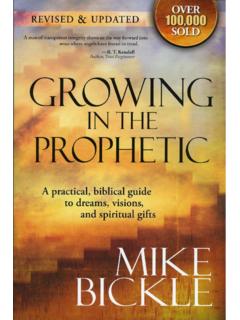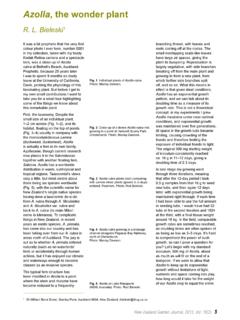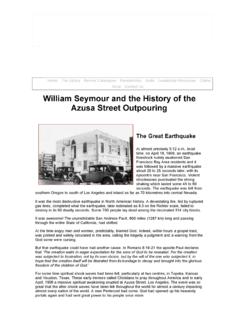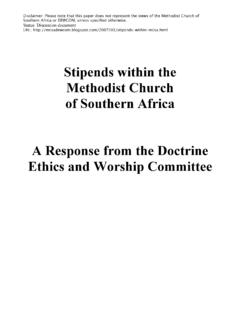Transcription of GOALS IN THE FORMATION OF THE SECULAR …
1 GOALS IN THE FORMATION OF THE SECULAR carmelite 1. To divest ourselves of attachments to worldly and spiritual goods, in order to arrive at union with God through contemplative prayers. This implies a desire to be perfected in the evangelical counsels of poverty, chastity and obedience, and in the spirit of the Beatitudes. 2. To grow in the theological virtues which unite us with God: faith, hope and charity. In the purification (active and passive) of the intellect we grow in faith. In the purification of the memory we grow in hope, and in the purification of the will we grow in charity. 3. To open ourselves more fully to God s grace by a consistent daily life of prayer, worship and sacrifice, having frequent recourse to the sacraments of the Eucharist and Penance. 4. To imitate the virtues and hidden life of our beloved Mother, Mary, and to deepen our relationship with her as we respond to her maternal guidance in our daily lives.
2 5. To help each other (and others in general) by our good example of selflessness and unconditional love. As we grow in a true spirit of community among ourselves and realize that we are a vital part of the Church as a whole, we should realize our great responsibility to witness to the world in a way which will cause them to exclaim, See how these Christians love one another! 6. To grow in our appreciation and knowledge of Holy Scripture and the doctrines of our Holy Mother Church, so that we may be better able to define and defend our faith and resist the snares of the enemy. 7. To grow in understanding of how it is both possible and beneficial for us to live contemplatively while remaining in the world and how this witness is a most pressing one in today s society. 8. To familiarize ourselves with the writings of our carmelite saints, who have been designated by the Church as our trustworthy guides in the spiritual journey, and to broaden our knowledge of the history of our Order, which formed them.
3 9. To grow in service of the Church by our prayers and sacrifices, and to offer to help in our local parishes wherever we are needed. In particular we should respond to the ever-present need to pray for our priests, and for new vocations. OCDS CONSTITUTIONS Development: The Third Order of Our Lady of Mt. Carmel was approved in 1452. Bl. John Soreth drew up our rule based on the Rule of St. Albert on March 12, 1455. Different areas throughout Europe did their own translation for a more practical version in their own languages and their different leadership. Another version was later drawn in 1678 as a way to unify the different groups. Again another version came out in 1883 for both Calced and Discalced Carmelites, under the Superior of the Order. First English version was 1912/14. In 1921 The Manual was written to give order and structure to the Third Order in accordance with the Code of Canon Law of 1918.
4 After Vatican II, the Manual was updated and OCDS Rule of 1974 came into existence. There it is no longer referred to as the Third Order now is the SECULAR Order of the Discalced Carmelites. It was officially approved in 1979. Now after the New Code of Canon Law 1983, the Synods of 1987 & 1996, issues of identity in the Order have been clarified and a new legislation for the OCDS was needed. One basic change was adding the Rule Of St. Albert to our documents. Working within the Order s GOALS of Back to the Essentials , the current revision of the OCDS Constitutions of 2003 were developed (the first one to be drawn up by OCDS membership worldwide). 1979 RULE (29 Articles) 2003 CONSTITUTIONS (59 Articles) Rule of St. Albert Rule of St. Albert Forward Preface I) Nature of OCDS Order (3 art.
5 I) Identity, values and commitment (9 art.) II) Daily Life (6 art.) II) Following Jesus in Teresian OCDS (7 art.) III) FORMATION (8 art.) III) Witness to the Experience of God (8 art.) IV) Structure (12 art.) IV) Serving God s Plan (4 art.) V) With Mary, the Mother of Jesus (3 art.) VI) FORMATION in the school of Carmel (5 art.) VII) Organization and Government (24 art.) -deeper sense of Biblical Tradition-experience of God -importance of Promises/Commitment to Carmel-God s Will -more emphasis of Mary as our Model-devotion to Our Lady of Mt. Carmel -greater emphasis on our role in the Church and the Order Key section: IV Serving God s Plan-answering the Church s call for evangelization. Sections III, IV,V-Heart of carmelite Life Chapter 1: Our Identity, Values and Commitment - SECULAR is our nature and identity-different from nuns and friars.
6 Difference between spirituality and vocation: devout and prayerful vs. the desire to make every effort to pray the best every day. -Called by the Holy Spirit to the OCDS way of life and deepen one s Baptismal commitment. Jealous zeal for Yahweh Personal Call-the person has a feeling that God is calling them or feels drawn to a specific charism. Eccelesial Call: in joining a religious order, a vocation must be ratified by the Church-and therefore needs approval by the appointed OCDS Council. General view of the history of the carmelite Order: Roots in the Hermits of Mount Carmel in the 13th Century. *Biblical Roots-St. Elijah (1 King: Chapter 17) 1206-1214 Rule of St. Albert 1240-Moving to Europe 1300 s-adapting and growing and adjust 1432-issue of relaxing the Rule 1562-St. Teresa reforms with St. John of the Cross the carmelite Order-Discalced.
7 1581-separation of Calced and Discalced Orders. 1602-First Carmelites to USA-California Key Elements to the carmelite Spirituality over time; -Christocentric-importance of Scripture -Marian-devotion to Our Lady -Contemplative-intense personal relationship with God -Prophetic-being aware of God s active presence in the world -Importance of the Rule of St. Albert to the OCDS carmelite Spirit -Origin of the Discalced carmelite Order through the founders: St. Teresa of Jesus and St. John of the Cross within the OCDS Constitutions **Importance of #9; The Fundamental Elements of the OCDS Vocation** (pg. 1-6 of What Are You Seeking?) Chapter 2: Following Jesus In The Teresian SECULAR Carmel Reminder of our values: -Christocentric -invited by the call of the Holy Spirit -deepening our Baptismal Commitment Three Fundamental Gospel Demands: -kingdom of God first -detachment from wealth/status -acceptance of God s Will Importance of Commitment to the OCDS Way of Life: striving for evangelical perfection in the spirit of the evangelical counsels of: -chastity -poverty -obedience And the Spirit of the Beatitudes: (development of the spiritual life) Gospel of Matthew 5 1) Poor in Spirit 2) Gentleness 3) Mourn 4) Hunger and thirst for uprightness 5) Merciful 6) Pure of heart 7) Peacemakers 8) Persecution in the cause of uprightness **Goal of the Kingdom of God-God s Presence known** (pg.
8 28-29 What Are You Seeking?) (pg. 477-480 Catechism of The Catholic Church) Chapter 3: Witness to the Experience of God SECULAR Carmelites are called to strive to make prayer penetrate their whole existence in order to walk in the presence of the living (cf 1 Kings 18:14) (OCDS Constitutions Ch. 3, ) -Center of the Constitutions and the OCDS Way of Life our relationship with God Prayer life Commitment: -time -place -attitude -material (pg. 9-10, 16-18 What Are You Seeking?) (pg. 673-710 - Ch. 4, section 1-3 Catechism of The Catholic Church) Chapter 3-B: Witness to the Experience of God SECULAR Carmelites are called to strive to make prayer penetrate their whole existence in order to walk in the presence of the living (cf 1 Kings 18:14) (OCDS Constitutions Ch. 3, ) Prayer Life and growing in Prayer Progression: Vocal Mental Prayer of Quiet Prayer of Union Remember Holiness is following God s Will for us Liturgical and Sacramental life of a SECULAR carmelite Eucharist Reconciliation Praying the Liturgy of the Hours Again the importance of: Time, Place and Attitude -Morning and Evening Prayer -Value of Night Prayer (pg.
9 31-36 What Are You Seeking?) (Part 2: Sacraments Catechism of The Catholic Church) (Part 4: Christian Prayer Catechism of The Catholic Church) Difficulties in a Prayer Life External Issues: Lifestyle: home life, job, other commitments, perceptions/misunderstanding from others, time and place, Internal Issues: Feeling of Vocation, being able to make commitment, personal attitudes and flexibility, emotional issues and being able to persevere, Prayer is our loving relationship with God, who loved us first-raising our minds and hearts to Him, thinking and loving Him. This leads us to two major concerns about prayer: distractions and aridity. exterior-space/physical issues Distractions: thoughts which come to us (mind) interior-containing thoughts Distractions are very common experiences can and must be reduced can not be completely reduced must not discourage the soul from perseverance exterior physical issues Aridity.
10 Withdrawal of the experience of consolation (will) interior-mental issues perserverance God s movement Aridity is a sometime thing and maybe God s time involved- need to maintain self-care and deepen our sense of our love for God- becoming a self-less love (not based on feelings) Willing to grow in prayer and be detached: (God s Will/Movement)-(not just saying prayers) -discursive meditation (we work at) -acquired meditation-prayer of recollection -infused comtemplation-prayer of quiet -prayer of union Spiritual Reading The following guidelines are from the book, A Practical Guide to Spiritual Reading, by Susan Muto 1) Careful selection of texts first from Holy Scripture and from various sources in the literature of spirituality.










